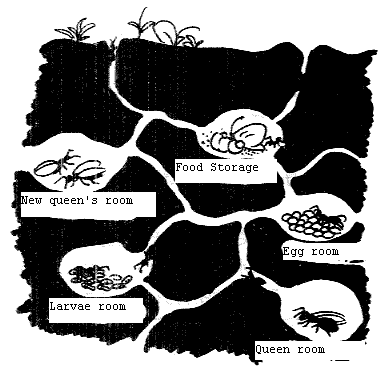
Internet version [Naruhodo no Mori] Vol.40
by Yumiko Mori

Vol. 40 July 15th, 1998
Observing Ants
Home science experiments for mothers of elementary school children
Mom: "This is really amazing. "
Dad: "What is so amazing?"
Mom: "Have you seen any ant nest entrance?
Did you notice entrance is surrounded by small sand hill?"
Dad: "Yes, I've seen before.
Isn't it the result of nest making by ants?"
Mom: "That is true.
But apparently you can also see these sand hill after rain shower."
Dad: "I wonder why?"
Mom: "Because nests collapse by rain water.
Well, I have an idea!"
Immediately Mom goes out to the yard.
She is holding a cup filled with water.
Satoshi, her five years old son, follows her.
Satoshi: "Mom, what are you doing?"
Mom: "I 'm going to make artificial rain."
Satoshi: "Oh, you put water into the ant nest."
Mom: "Watch what's going to happen, Satoshi!"
Satoshi: "Look! All the ants are coming out of the nest."
Mom: "They are all in panic, because suddenly water flew into their house.
Satoshi, what are you going to do, if water falls into our house like shower?"
Satoshi: "I'm going to escape."
Mom: "That's exactly what ants did."
Mom and Satoshi watch what ants are doing afterwards.
Some ants are bringing food.
Some ants seem just wondering.
The other ants seem talking each other or pushing each other.
Mom: "Look at this ant!"
Satoshi: "The ant is carrying a sand bit."
Mom: "I guess they are repairing their house."
Satoshi: "These ants are working hard."
Mom: "Another ant is bringing a sand bit too."
Satoshi: "OK. If water falls into our house, I would help repairing our house as well."
* Worker ants are female.
They take care of larvae.
If you watch carefully, you'll find different behaviors among ants.
Some are just wondering.
Others are bringing sand or food.
I have learned this difference may come from ant age and experience.
I guess that wondering ants are very young.
Materials
Observing ants
 Required time: 30 minutes (Time can pass quickly once you get to enjoy observing ants.)
Required time: 30 minutes (Time can pass quickly once you get to enjoy observing ants.)
- If you find an ant, follow where she goes.
Do not disturb ant passage, since they get lost easily.
Find an entrance for their underground nest
- Pour water into the entrance.
Do not pour too much water, or the nest gets destroyed completely.
- Watch what ants are going to do in response to water.
You may get tired in crouching position.
You may sit on a picnic rug or newspapers.
- Watch ants quietly around their nests. Don't scare them.
- Leave food (such as sugar) around ant nests.
You can observe what they do with food.
- Observe how ants carry food or sands.
Watch how they carry heavy items.
- Find out the name of the ants you observed.
A library may be one of the best places to find such information.
Ants Observation - My Own Experiment
I wondered whether the same ants were always responsible in bringing sand bits.
I wanted to test this hypothesis.
I realized I could mark each ant by painting.
So I decided to put white paint mark on ants that were carrying sands.
This attempt turned out to be quite difficult.
Those ants went back to the nest as soon as they dropped sand bits.
I had very little time to mark those ants.
In order to trap ants, I built a small plastic tube by cutting off the bottom of a film case.
Using this plastic tube, I caught ants and managed to paint some of them.
It looked promising initially, but unfortunately this still didn't work.
Painted ants seemed so shocked that they were just wondering.
And they were also poked by the other ants.
In the end, I couldn't see the same ants were bringing sand bits again.
Usually ants can tell their own nest from the other nests by smell.
So this paint smell might have made these ants among their colleagues.
I felt sorry for those ants.
What is not known
Since I observed ants, I became curious about ant life.
What do ant feces look like?
How do ants sleep?
How can they walk with 6 legs?
I started to read several children books about ants.
Those books described about nest building and queens, but did not give answers to my naive questions.
I realized books can tell me not only what is known, but also what is not known.
| Author | Yumiko Mori (Zushi, Kanagawa, Japan) |
|---|
| Illustration | Mitsue Ogata |
|---|
| Translator | Akira Ishihara |
|---|
| HTML format | Muneo Kume |
|---|
Copyright © 1998 Rika no Heya & Yumiko Mori






 Required time: 30 minutes (Time can pass quickly once you get to enjoy observing ants.)
Required time: 30 minutes (Time can pass quickly once you get to enjoy observing ants.)
